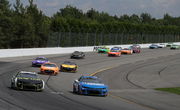
via Imago
Austin Dillon and Denny Hamlin | Image Credits: Imago

via Imago
Austin Dillon and Denny Hamlin | Image Credits: Imago
The ramifications of the Richmond incident just do not seem to end. Yet another eye-opening aspect about the wrecks that were intentionally induced by Austin Dillon has been revealed. It was not the end of the story for Denny Hamlin’s crew chief, Chris Gabehart when he accorded with Paul Wolfe’s accusations.
The narrative evolves as a case unfolds and more evidence is presented. In Austin Dillon’s Richmond case, even with the naked eye, the wrongdoing was evident. But more proof has surfaced that can back the initial claims.
ADVERTISEMENT
Article continues below this ad
Why is it being compared to Kurt Busch’s last crash?
Remember the 2022 Pocono incident when Kurt Busch lost control of his No. 45 Toyota, sending it careening up the track? The right rear slammed hard into the wall, and the impact was brutal. As the car whipped around, the front nose violently tagged the wall as well, leaving everyone holding their breath. The rear impact alone registered a staggering 30 G’s—just for comparison, modern fighter pilots experience about nine G’s. The front hit clocked in at 18 G’s, raising serious concerns about the safety of the Next Gen cars. Thanks to Austin Dillon, Denny Hamlin experienced something similar, even bigger in Richmond.
There is a difference between slight brushing of cars while going sideways or paint-nipping bumps and an all-out abrasive crash. The crashes that culminated in Austin Dillon’s Richmond victory were of the latter kind, as ruled by NASCAR officials. And there’s something to hint at how disastrous such an attempt to wreck a fellow driver’s car can be.
In July 2022, after that crash, Kurt Busch immediately apologized, showing his usual class. He then stepped out of the car, waved to the crowd, and reassured everyone he was Ok before heading to the waiting ambulance. Since that incident, he hasn’t been back in a Cup car for a race. After Dillon was declared the winner, the No. 11 JGR driver didn’t wave, but he did approve of his actions.
Now, four days later, as reviews unfolded and NASCAR docked Dillon of some important playoff points, Denny Hamlin’s crew chief Chris Gabehart has detailed the magnitude of the No. 11’s hit. He said, “Do you know when the highest recorded G spike in the history of Gen 7 was for JGR? It was at Richmond in the #11 car. Sunday night, 32G spike in the wall off of turn 4 coming to the checkered flag.” The staggering amount of G-force spike suffered by Denny Hamlin’s car at Richmond is terrifying.
Danny Hamlin’s crew chief on @SiriusXMNASCAR says the 11 car hit the wall at Richmond with a 32G spike – the highest g-load ever for a JGR car in the Gen7 era. And higher than the crash that injured Kurt Busch forcing his retirement.
— Chris Weaver (@chris8video) August 15, 2024
No driver or team in the right consciousness would want to cause a scandalous disaster of epic proportions. But as it turns out, Austin Dillon and his spotter ended up committing such a blunder. The worst part is the team is still not ready to accept the mishap.
“Highest ever recorded, I must add higher than the one that unfortunately put Kurt Busch out of, put him in retirement ultimately at Pocono; higher than that. Some flagrant fouls are flagrant. They’re dangerouss,” added Chris Gabehart, explaining the horrendous implications of ramming into the wall.
Trending
ADVERTISEMENT
Article continues below this ad
Denny Hamlin’s crew chief on NASCAR’s penalty ruling?
The situation that Denny Hamlin was put into was egregious, and Chris Gabehart does not intend to state it any lightly. Although the precedent set by NASCAR is on point, Chris Gabehart still hopes that the officials were empowered enough to have called the foul in the face.
He opined, “The #11 car finished 2 either way, so it’s easier for me to say that they got it right. With the exception of this, I want us to get to a world where the officials feel empowered to make those decisions 60 hours ahead of time, live.” It makes sense because that’s their job, and they must be able to perform it without any hesitations or dirty politics.
It is also an appreciable practice to keep records of the data to verify or review conflicts. As Chris disclosed, “Every time you have a significant enough incident that warrants a further look into the incident data recorder, NASCAR will send you the data for that incident. JGRs has had 21 of those incidents in the Gen 7 era.”
ADVERTISEMENT
Article continues below this ad
Whenever any team would even consider getting away with foul play, it would be instantly reprimanded, asserting NASCAR’s authority. There’s no denying that the best-case scenario is still self-policing, but there also ought to be a readily available recourse in times of lapse.
How convinced are you with RCR’s penalty?
ADVERTISEMENT
ADVERTISEMENT
ADVERTISEMENT
ADVERTISEMENT






